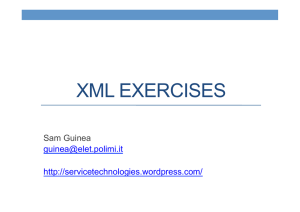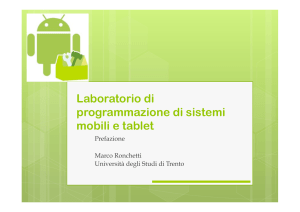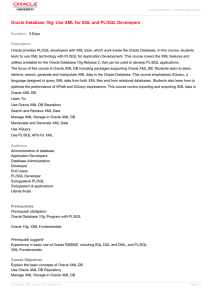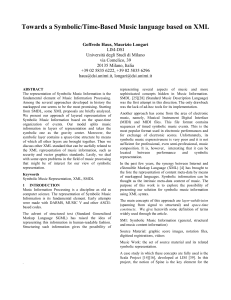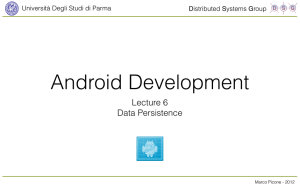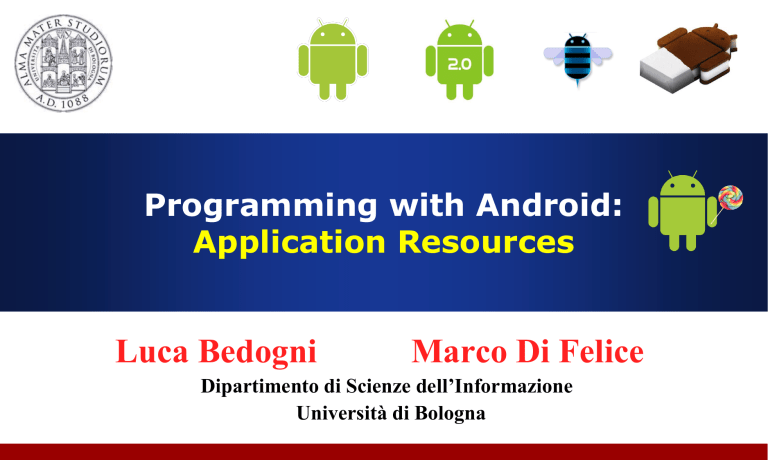
Programming with Android:
Application Resources
Luca Bedogni
Marco Di Felice
Dipartimento di Scienze dell’Informazione
Università di Bologna
Outline
What is a resource?
Declaration of a resource
Resource type: integer, string, array, color, style
Resource type: layout
Resource type: drawable, raw, xml
Accessing resources from XML and Java code
Providing Configuration-specific resources
Luca Bedogni, Marco Di Felice
-
Programming with Android – Resources
2
Android Applications Design
Developing an Android Application means using in a proper
way the Android basic components …
Activity
Fragment
Luca Bedogni, Marco Di Felice
-
Layout
Views
Intent
Content
Providers
Service
Broadcast
Receiver
Programming with Android – Resources
3
Application Resources Definition
An Android Application is composed of: code and resources.
Java code
Utilization of Resources… why?
Static data:
Text strings
Colors
Layout
Sound
Images
…
Separate data presentation (layout) from data management
Provide alternative resources to support specific device
configurations (e.g. different language packs)
Luca Bedogni, Marco Di Felice
-
Programming with Android – Resources
4
Application Resources Definition
PROBLEM. An Android application might run on heterogenous devices
with different characteristics (e.g. screen size, language support,
keyboard type, input devices, etc).
18,796 different devices in 2014!
Luca Bedogni, Marco Di Felice
-
Programming with Android – Resources
5
Application Resources Definition
The same application layout with 8 buttons, on a tablet
and on a smartphone device.
Luca Bedogni, Marco Di Felice
-
Programming with Android – Resources
6
Application Resources Definition
Handle the devices’ hetereogenity writing Java code?
1. Provide different versions of the Mobile Application
UNFEASIBLE
2. Support all configurations within a single App OK, but
code is full of if-then-else
ANDROID WAY. Separate code from UI. Use declative XMLbased approch to define resources (images, files, layout,
text, etc)
Luca Bedogni, Marco Di Felice
-
Programming with Android – Resources
7
Application Resources Definition
EXAMPLE
Device 1
Device 2
HIGH screen pixel density
LOW screen pixel density
Java App Code
XML Layout File
XML Layout File
Device 1
Device 2
Luca Bedogni, Marco Di Felice
-
- Build the application layout
through XML files (like HTML)
- Define two different XML layouts
for two different devices
- At runtime, Android detects the
current device configuration and
loads the appropriate resources
for the application
- No need to recompile!
- Just add a new XML file if you
need to support a new device
Programming with Android – Resources
8
Application Resources Definition
The same application layout with 8 buttons, on a tablet
and on a smartphone (Nexus 7) device.
LAYOUT
SMARTPHONE
Luca Bedogni, Marco Di Felice
LAYOUT
TABLET
-
Programming with Android – Resources
9
Application Resources Definition
Resources are defined in the res/ folder of the project.
MyProject
java
(Source Code Java)
MyActivity.java
res
Luca Bedogni, Marco Di Felice
-
layout
main.xml
(Application XML Layout)
values
strings.xml
(Application Labels)
drawable
icon.png
(Application Icons)
Programming with Android – Resources
10
Application Resources Definition
Resource Type
Resource contained
res/animator
XML files that define property animations.
res/anim
XML files that define tween animations.
res/drawable
Bitmap files (.png, .jpg, .gif) or XML files that
are compiled into other resources.
res/layout
XML files that define a user interface layout.
res/menu
XML files that define application menus.
res/mipmap
Drawable files for different launcher icon
densities
res/raw
Arbitrary files to save in their raw form.
res/values
XML files that contain simple values, such as
strings, integers, array.
res/xml
Arbitrary XML files.
Luca Bedogni, Marco Di Felice
-
Programming with Android – Resources
11
Application Resources Definition
(COMMON) CHARACTERISTICS of RESOURCES
Resources can be: XML files, XML tags, or raw files
(e.g. a picture or an audio file)
Each resource has a unique name or identifier (used to
identify/retrieve it from Java/XML code).
There might be multiple alternatives of the same
resource for different devices configuration (e.g. two
pictures, with same name, for different screen’s size).
Luca Bedogni, Marco Di Felice
-
Programming with Android – Resources
12
Application Resources Definition
Resource Type
Resource contained
res/animator
XML files that define property animations.
res/anim
XML files that define tween animations.
res/drawable
Bitmap files (.png, .jpg, .gif) or XML files that
are compiled into other resources.
res/layout
XML files that define a user interface layout.
res/menu
XML files that define application menus.
res/mipmap
Drawable files for different launcher icon
densities
res/raw
Arbitrary files to save in their raw form.
res/values
XML files that contain simple values, such as
strings, integers, array.
res/xml
Arbitrary XML files.
Luca Bedogni, Marco Di Felice
-
Programming with Android – Resources
13
Resources Types: string and array
Resource Type
File
Java constant
XML tag
Description
string
Any file in the
res/values/
R.string.<key>
<string>
String value
associated to a key.
integer
Any file in the
res/values/
R.integer.<key>
<integer>
Integer value
associated to a key.
array
Any file in the
res/values/
R.array.<key>
<string-array>
<item>
<item>
</string-array>
Array of strings.
Each element is a
described by an
<item>
array
Any file in the
res/values/
R.array.<key>
<integer-array>
<item>
<item>
</integer-array>
Array of integers.
Each element is a
described by an
<item>
Luca Bedogni, Marco Di Felice
-
Programming with Android – Resources
14
Resources Types: string and array
MYVALUES.XML
<?xml version="1.0" encoding="utf-8"?>
<resources>
<string name=“app_title”> My Application
</string>
<string name=“label” > Hello world!
</string>
<integer name=“myvalue”> 53 </integer>
</resources>
Luca Bedogni, Marco Di Felice
-
Programming with Android – Resources
15
Resources Types: string and array
MYVALUES.XML
<?xml version="1.0" encoding="utf-8"?>
<resources>
<string-array name=“nameArray”>
<item> John </item>
<item> Michael </item>
</string-array>
<integer-array name=“valArray”>
<item> 1 </item>
<item> 2 </item>
</integer-array>
</resources>
Luca Bedogni, Marco Di Felice
-
Programming with Android – Resources
16
Resources Types: color, dimension, style
Resource Type
File
Java constant
XML tag
Description
color
Any file in the
res/values/
R.color.<key>
<color>
Definition of colors
used in the GUI
dimension
Any file in the
res/values/
R.dimen.<key>
<dimen>
Dimension units of
the GUI
components
style
theme
Any file in the
res/values/
R.style.<key>
<style>
Themes and
styles used by
applications or by
components
Luca Bedogni, Marco Di Felice
-
Programming with Android – Resources
17
Resources Types: color, dimension, style
VALUES.XML
<?xml version="1.0" encoding="utf-8"?>
<resources>
<color name=“red”> #FF0000
</color>
<color name=“red_trasparent”> #66DDCCDD
</color>
</resources>
Color values can be defined based on one of these syntax
rules: #RGB, #ARGB, #RRGGBB, #AARRGGBB (R=red,
G=green, B=blue, A=transparency).
Luca Bedogni, Marco Di Felice
-
Programming with Android – Resources
18
Resources Types: color, dimension, style
Code
Description
px
Pixel units
in
Inch units
mm
Millimeter units
pt
Points of 1/72 inch
dp
Abstract unit, independent from pixel density of a display
sp
Abstract unit, independent from pixel density of a display (font)
These units are relative to a 160 dpi (dots per inch) screen, on which 1dp is roughly
equal to 1px. When running on a higher density screen, the number of pixels used
to draw 1dp is scaled up by a factor appropriate for the screen's dpi.
Luca Bedogni, Marco Di Felice
-
Programming with Android – Resources
19
Resources Types: color, dimension, style
VALUES.XML
<?xml version="1.0" encoding="utf-8"?>
<resources>
<dimen name=“widthButton”> 50dp
</dimen>
<dimen name=“sizeText”> 14sp
</dimen>
<dimen name=“heightButton”> 14px
</dimen>
</resources>
Luca Bedogni, Marco Di Felice
-
Programming with Android – Resources
20
Resources Types: color, dimension, style
MYVALUES.XML
<?xml version="1.0" encoding="utf-8"?>
<resources>
<style name="CustomText" parent="@style/Text">
<item name="android:textSize">20sp
</item>
<item name="android:textColor">#008
</item>
</style>
</resources>
A Style is a set of attributes that can be applied to a specific
component of the GUI (View) or to the whole screen or application
(in this case, it is also referred as “theme”).
Luca Bedogni, Marco Di Felice
-
Programming with Android – Resources
21
Application Resources Definition
Resource Type
Resource contained
res/animator
XML files that define property animations.
res/anim
XML files that define tween animations.
res/drawable
Bitmap files (.png, .jpg, .gif) or XML files that
are compiled into other resources.
res/layout
XML files that define a user interface layout.
res/menu
XML files that define application menus.
res/mipmap
Drawable files for different launcher icon
densities
res/raw
Arbitrary files to save in their raw form.
res/values
XML files that contain simple values, such as
strings, integers, array.
res/xml
Arbitrary XML files.
Luca Bedogni, Marco Di Felice
-
Programming with Android – Resources
22
Resources Types: layout
A Layout resource is an XML file describing
the User Interface of the Component (e.g.
Activity)
<TextView
android:layout_width="wrap_content"
android:layout_height="wrap_content"
android:text=”Hello World!
android:id="@+id/mytext" />
Luca Bedogni, Marco Di Felice
-
Programming with Android – Resources
23
Resources Types: layout
A Layout File is composed of Views
Each XML Tag is a View
View type
View properties
<TextView
android:layout_width="wrap_content"
android:layout_height="wrap_content"
android:text=”Hello World!
android:id="@+id/mytext" />
Luca Bedogni, Marco Di Felice
-
View ID
Programming with Android – Resources
24
Resources Types: layout
A Layout File is composed of ViewGroup
<LinearLayout
android:orientation="vertical"
android:layout_width="fill_parent"
android:layout_height="fill_parent”>
<TextView
android:layout_width="wrap_content"
android:layout_height="wrap_content"
android:text=”Hello World!
android:id="@+id/mytext" />
<LinearLayout/>
Luca Bedogni, Marco Di Felice
-
Programming with Android – Resources
25
Resources Types: layout
TextView
EditText
Button
ToggleButton
Spinner
DataPicker
Luca Bedogni, Marco Di Felice
-
Programming with Android – Resources
26
Application Resources Definition
Resource Type
Resource contained
res/animator
XML files that define property animations.
res/anim
XML files that define tween animations.
res/drawable
Bitmap files (.png, .jpg, .gif) or XML files that
are compiled into other resources.
res/layout
XML files that define a user interface layout.
res/menu
XML files that define application menus.
res/mipmap
Drawable files for different launcher icon
densities
res/raw
Arbitrary files to save in their raw form.
res/values
XML files that contain simple values, such as
strings, integers, array.
res/xml
Arbitrary XML files.
Luca Bedogni, Marco Di Felice
-
Programming with Android – Resources
27
Resources Types: drawable
A Drawable resource is a general concept for a graphic that
can be drawn to the screen.
BitMapFile: .jpeg, .png, .gif file
XML File: define a shape, a graphic effect, a
transition between different states, etc
res
drawable
Luca Bedogni, Marco Di Felice
-
science.png
Programming with Android – Resources
28
Resources Types: drawable
A Drawable resource is a general concept for a graphic that
can be drawn to the screen.
BitMapFile: .jpeg, .png, .gif file
XML File: define a shape, a graphic effect, a
transition between different states, etc
res
drawable
Luca Bedogni, Marco Di Felice
-
science.png
Programming with Android – Resources
29
Resources Types: drawable
A Drawable resource is a general concept for a graphic that
can be drawn to the screen.
Drawable type
Description
BitMap File
A bitMap Graphic file (.png, .gif. .jpeg)
Nine-Patch File
A PNG file with stretchable regions to allow resizing
Layer List
A Drawable managing an array of other drawable
State List
A Drawable that references different graphics based on the states
Level List
An XML managing alternate Drawables. Each assigned a value
Transition
A Drawable that can cross-fade between two Drawable
Inset
A Drawable that insets another Drawable by a specific distance
Clip
A Drawable that clips another Drawable based on its current level
Scale
A Drawable that changes the size of another Drawable
Shape
An XML file that defines a geometric shape, colors and gradients
Luca Bedogni, Marco Di Felice
-
Programming with Android – Resources
30
Resources Types: drawable
A Drawable resource is a general concept for a graphic that
can be drawn to the screen.
MYSHAPE.XML
<?xml version="1.0" encoding="utf-8"?>
<shape xmlns:android="http://schemas.android.com/apk/res/android"
android:shape="rectangle">
<gradient
android:startColor="#FFFF0000"
android:endColor="#80FF00FF"
android:angle="45"/>
<padding android:left="7dp"
android:top="7dp"
android:right="7dp"
android:bottom="7dp" />
<corners android:radius="8dp" />
</shape>
Luca Bedogni, Marco Di Felice
-
Programming with Android – Resources
31
Resources Types: drawable
A Drawable resource is a general concept for a graphic that
can be drawn to the screen.
MYSELECTOR.XML
<?xml version="1.0" encoding="utf-8"?>
<selector xmlns:android="http://schemas.android.com/apk/res/android">
<item android:state_pressed="true"
android:drawable="@drawable/button_pressed" />
<item android:state_focused="true"
android:drawable="@drawable/button_focused" />
<item android:state_hovered="true"
android:drawable="@drawable/button_focused" />
<item android:drawable="@drawable/button_normal" />
</selector>
Luca Bedogni, Marco Di Felice
-
Programming with Android – Resources
32
Access to Application Resources
Each Resource is associated with an Identifier (ID), that is
composed of two parts:
The resource type: Each resource is grouped into a "type,” (e.g.
string, color, menu, drawable, layout, etc)
The resource name, which is either: the filename, excluding the
extension; or the value in the XML <android:name> attribute.
Identifiers must be unique!!
Two ways to access resources:
From the XML Code
From the Java Code
Luca Bedogni, Marco Di Felice
-
Programming with Android – Resources
33
Access to Application Resources
Each Resource is associated with an Identifier (ID), that is
composed of two parts:
The resource type: Each resource is grouped into a "type,” (e.g.
string, color, menu, drawable, layout, etc)
The resource name, which is either: the filename, excluding the
extension; or the value in the XML <android:name> attribute.
Identifiers must be unique!!
Two ways to access resources:
From the XML Code
From the Java Code
Luca Bedogni, Marco Di Felice
-
Programming with Android – Resources
34
Access to Application Resources: XML
@[<package_name>:]<resource_type>/<resource_name>
<package_name> is the name of the package in which
the resource is located (not required when referencing
resources from the same package)
<resource_type> is the the name of the resource type
<resource_name> is either the resource filename without
the extension or the android:name attribute value in the
XML element.
Luca Bedogni, Marco Di Felice
-
Programming with Android – Resources
35
Access to Application Resources: XML
VALUE RESOURCE /res/value folder
STRINGS.XML
<?xml version="1.0" encoding="utf-8"?>
<resources>
<string name=”labelButton”> Submit </string>
<string name=”labelText”> Hello world! </string>
</resources>
LAYOUT RESOURCE /res/layout folder
<?xml version="1.0" encoding="utf-8"?>
<resources>
<Textview android:id=“@+id/label1”
android:text=“@string/labelText” />
<Button android:id=“@+id/button1”
android:text=“@string/labelButton”/>
</resources>
Luca Bedogni, Marco Di Felice - Programming with Android – Resources
MAIN_ACTIVITY.XML
36
Access to Application Resources: XML
LAYOUT RESOURCE /res/layout folder
MAIN_ACTIVITY.XML
<?xml version="1.0" encoding="utf-8"?>
<resources>
<ImageView
android:id=“@+id/label1”
android:src=“@drawable/science” />
</resources>
DRAWABLE RESOURCE /res/drawable folder
res
drawable
Luca Bedogni, Marco Di Felice
-
science.png
Programming with Android – Resources
37
Access to Application Resources
Each Resource is associated with an Identifier (ID), that is
composed of two parts:
The resource type: Each resource is grouped into a "type,” (e.g.
string, color, menu, drawable, layout, etc)
The resource name, which is either: the filename, excluding the
extension; or the value in the XML <android:name> attribute.
Identifiers must be unique!!
Two ways to access resources:
From the XML Code
From the Java Code
Luca Bedogni, Marco Di Felice
-
Programming with Android – Resources
38
Access to Application Resources: Java
Each XML Resource has a correspective Java Object
XML
JAVA
INFLATING PROCESS
AT RUNTIME
<TextView
android:layout_width="wrap_content"
android:layout_height="wrap_content"
android:text=”Hello World!
android:id="@+id/mytext" />
Luca Bedogni, Marco Di Felice
-
class TextView extends View {
...
CharSequence getText();
void getText(CharSequence);
}
Programming with Android – Resources
39
Access to Application Resources: Java
Each XML Resource has a correspective Java Object
XML
JAVA
INFLATING PROCESS
AT RUNTIME
PROBLEM. How to refer to a specific XML resource with a given name?
ANSWER. Through the R class, that works as a glue between the
world of java and the world of resources
Luca Bedogni, Marco Di Felice
-
Programming with Android – Resources
40
Access to Application Resources: Java
STRINGS.XML
<?xml version="1.0" encoding="utf-8"?>
<resources>
<string name="hello”> Hello world! </string>
<string name=”lButton"> Insert your username </string>
</resources>
R.JAVA GENERATED AUTOMATICALLY, NO NEED TO MODIFY IT!
R.JAVA
public final class R {
public static final class string {
public static final int hello=0x7f040001;
public static final int lbutton=0x7f040005;
}
}
Luca Bedogni, Marco Di Felice
-
Programming with Android – Resources
R contains
resource IDs for
all the resources in
the res/ directory.
41
Access to Application Resources: Java
[<package_name>.]R.<resource_type>.<resource_name>
<package_name> is the name of the package in which
the resource is located (not required when referencing
resources from the same package)
<resource_type> is the R subclass for the resource type
<resource_name> is either the resource filename without
the extension or the android:name attribute value in the
XML element.
Luca Bedogni, Marco Di Felice
-
Programming with Android – Resources
42
Access to Application Resources: Java
STEP0: Declare resources in res/
<?xml version="1.0" encoding="utf-8"?>
<resources>
STEP2: Access resources through R class
public final class R {
public static final class string {
public static final int hello=0x7f040001;
public static final int label1=0x7f040005;
}
<string name="hello”> Hello </string>
<string name="label1"> Label </string>
</resources>
}
XML-Based, Declarative Approach
Java Code, Programmatic Approach
STEP1: Compile the project
Luca Bedogni, Marco Di Felice
-
Programming with Android – Resources
43
Access to Application Resources: Java
getResources()
Get accesses to all resources of the application
getResources().getTTT(Name)
Get accesses to all resources of the application of type
TTT and with name equal to Name
String getResources().getString(name)
int getResouces().getInt(name)
int getResources().getColor(name)
Drawable getResources().getDrawable(name)
…
Luca Bedogni, Marco Di Felice
-
Programming with Android – Resources
44
Access to Application Resources: Java
EXAMPLE of JAVA code accessing RESOURCES
// Get a string resource named hello
String hello=getResources().getString(R.string.hello);
// Get a color resource named opaque_red
int color=getResources().getColor(R.color.opaque_red);
// Access an integer-array resource
int val[]=getResources().getIntArray(R.array.valArray);
// Access a Drawable resource
Drawable d=getResources().getDrawable(R.drawable.img);
Luca Bedogni, Marco Di Felice
-
Programming with Android – Resources
45
Access to Application Resources: Java
View findViewById(ID)
Get accesses to a View object with identifier ID
EXAMPLE of JAVA code accessing LAYOUT RESOURCES
// Access to a TextView with ID equal to label1
TextView msgTextView = (TextView)
findViewById(R.id.label1);
msgTextView.setText(getResources().getString(R.string
.stringText));
Luca Bedogni, Marco Di Felice
-
Programming with Android – Resources
46
Access to Application Resources: Java
View findViewById(ID)
Get accesses to a View object with identifier ID
EXAMPLE of JAVA code accessing LAYOUT RESOURCES
// Access to a Button with ID equal to button1
Button myButton= (Button)
findViewById(R.id.button);
myButton.setTextColor(getResources().getColor(R.color
.deepblue));
Luca Bedogni, Marco Di Felice
-
Programming with Android – Resources
47
Resources Alternatives
Android applications might provide alternative resources
to support specific device configurations (e.g. different languages).
At runtime, Android detects the current device configuration and
loads the appropriate resources for the application.
To specify configuration-specific alternatives:
1. Create a new directory in res/ named in the form
<resources_name>-<config_qualifier>
2. Save the respective alternative resources in this new directory
Luca Bedogni, Marco Di Felice
-
Programming with Android – Resources
48
Resources Alternatives
Name of the folder: <resources_name>-<config_qualifier>.
<resources_name> is the directory name of the corresponding
default resources (see previous slides).
<qualifier> is a name that specifies an individual configuration for
which these resources are to be used (see next slide).
res
values-it
values-en
Luca Bedogni, Marco Di Felice
-
Programming with Android – Resources
Values for the IT locale
Values for the EN locale
49
Resources Alternatives: Qualifiers
Configuration
Values Example
Description
MCC and MNC
mcc310, mcc208, etc
mobile country code (MCC)
Language and region
en, fr, en-rUS, etc
ISO 639-1 language code
smallestWidth
sw320dp, etc
shortest dimension of screen
Available width
w720dp, w320dp, etc
minimum available screen width
Available height
h720dp, etc
minimum available screen height
Screen size
small, normal, large
screen size expressed in dp
Screen aspect
long, notlong
aspect ratio of the screen
Screen orientation
port, land
screen orientation (can change!)
Screen pixel density (dpi)
ldpi, mdpi, hdpi
screen pixel density
Keyboard availability
keysexposed, etc
type of keyword
Primary text input method
nokeys, qwerty
availability of qwerty keyboard
Navigation key availability
navexposed, etc
navigation keys of the application
Platform Version (API level)
v3, v4, v7, etc
API supported by the device
Luca Bedogni, Marco Di Felice
-
Programming with Android – Resources
50
Resources Alternatives Matching
When the application
requests a resource for which
there are multiple
alternatives, Android selects
which alternative resource
to use at runtime, depending
on the current device
configuration, through the
algorithm shown in the
Figure.
Luca Bedogni, Marco Di Felice
-
Programming with Android – Resources
51
Resources Alternatives Matching
DEVICE CONFIGURATION
Locale = it Screen orientation = port
Screen pixel density = hdpi
Touchscreen type = notouch
Primary text input method = 12key
drawable/
drawable-it/
drawable-fr-rCA/
drawable-it-port/
drawable-it-notouch-12key/
drawable-port-ldpi/
drawable-port-notouch-12key/
Luca Bedogni, Marco Di Felice
-
Programming with Android – Resources
52
Resources Alternatives Matching
DEVICE CONFIGURATION
Locale = it Screen orientation = port
Screen pixel density = hdpi
Touchscreen type = notouch
Primary text input method = 12key
drawable/
drawable-it/
drawable-fr-rCA/
drawable-it-port/
drawable-it-notouch-12key/
drawable-port-ldpi/
drawable-port-notouch-12key/
Luca Bedogni, Marco Di Felice
-
Programming with Android – Resources
53
Resources Alternatives Matching
DEVICE CONFIGURATION
Locale = it Screen orientation = port
Screen pixel density = hdpi
Touchscreen type = notouch
Primary text input method = 12key
drawable/
drawable-it/
drawable-fr-rCA/
drawable-it-port/
drawable-it-notouch-12key/
drawable-port-ldpi/
drawable-port-notouch-12key/
Luca Bedogni, Marco Di Felice
-
Programming with Android – Resources
54
Resources Alternatives
BEST PRACTICES
Provide default resources for your application.
Provide alternative resources based on the
target market of your application.
Avoid unnecessary or unused resources
alternatives.
Use alias to reduce the duplicated resources.
Luca Bedogni, Marco Di Felice
-
Programming with Android – Resources
55

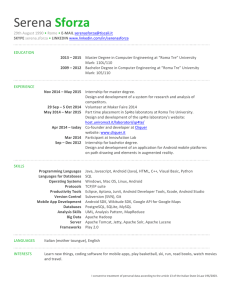


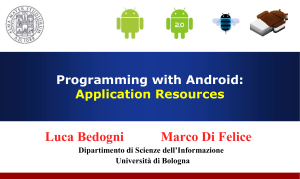


![Crazy Blues [Opus n.40] - Free](http://s1.studylibit.com/store/data/003698511_1-86b1722678746b749483727629bbbce4-300x300.png)
